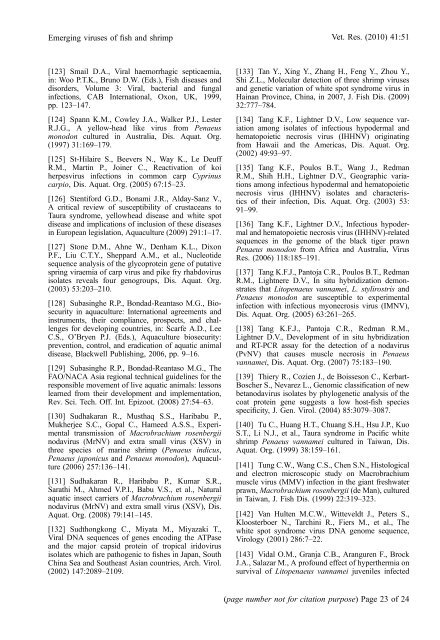Emerging viral diseases of fish and shrimp - Watershed Watch ...
Emerging viral diseases of fish and shrimp - Watershed Watch ...
Emerging viral diseases of fish and shrimp - Watershed Watch ...
Create successful ePaper yourself
Turn your PDF publications into a flip-book with our unique Google optimized e-Paper software.
<strong>Emerging</strong> viruses <strong>of</strong> <strong>fish</strong> <strong>and</strong> <strong>shrimp</strong> Vet. Res. (2010) 41:51<br />
[123] Smail D.A., Viral haemorrhagic septicaemia,<br />
in: Woo P.T.K., Bruno D.W. (Eds.), Fish <strong>diseases</strong> <strong>and</strong><br />
disorders, Volume 3: Viral, bacterial <strong>and</strong> fungal<br />
infections, CAB International, Oxon, UK, 1999,<br />
pp. 123–147.<br />
[124] Spann K.M., Cowley J.A., Walker P.J., Lester<br />
R.J.G., A yellow-head like virus from Penaeus<br />
monodon cultured in Australia, Dis. Aquat. Org.<br />
(1997) 31:169–179.<br />
[125] St-Hilaire S., Beevers N., Way K., Le Deuff<br />
R.M., Martin P., Joiner C., Reactivation <strong>of</strong> koi<br />
herpesvirus infections in common carp Cyprinus<br />
carpio, Dis. Aquat. Org. (2005) 67:15–23.<br />
[126] Stentiford G.D., Bonami J.R., Alday-Sanz V.,<br />
A critical review <strong>of</strong> susceptibility <strong>of</strong> crustaceans to<br />
Taura syndrome, yellowhead disease <strong>and</strong> white spot<br />
disease <strong>and</strong> implications <strong>of</strong> inclusion <strong>of</strong> these <strong>diseases</strong><br />
in European legislation, Aquaculture (2009) 291:1–17.<br />
[127] Stone D.M., Ahne W., Denham K.L., Dixon<br />
P.F., Liu C.T.Y., Sheppard A.M., et al., Nucleotide<br />
sequence analysis <strong>of</strong> the glycoprotein gene <strong>of</strong> putative<br />
spring viraemia <strong>of</strong> carp virus <strong>and</strong> pike fry rhabdovirus<br />
isolates reveals four genogroups, Dis. Aquat. Org.<br />
(2003) 53:203–210.<br />
[128] Subasinghe R.P., Bondad-Reantaso M.G., Biosecurity<br />
in aquaculture: International agreements <strong>and</strong><br />
instruments, their compliance, prospects, <strong>and</strong> challenges<br />
for developing countries, in: Scarfe A.D., Lee<br />
C.S., O’Bryen P.J. (Eds.), Aquaculture biosecurity:<br />
prevention, control, <strong>and</strong> eradication <strong>of</strong> aquatic animal<br />
disease, Blackwell Publishing, 2006, pp. 9–16.<br />
[129] Subasinghe R.P., Bondad-Reantaso M.G., The<br />
FAO/NACA Asia regional technical guidelines for the<br />
responsible movement <strong>of</strong> live aquatic animals: lessons<br />
learned from their development <strong>and</strong> implementation,<br />
Rev. Sci. Tech. Off. Int. Epizoot. (2008) 27:54–63.<br />
[130] Sudhakaran R., Musthaq S.S., Haribabu P.,<br />
Mukherjee S.C., Gopal C., Hameed A.S.S., Experimental<br />
transmission <strong>of</strong> Macrobrachium rosenbergii<br />
nodavirus (MrNV) <strong>and</strong> extra small virus (XSV) in<br />
three species <strong>of</strong> marine <strong>shrimp</strong> (Penaeus indicus,<br />
Penaeus japonicus <strong>and</strong> Penaeus monodon), Aquaculture<br />
(2006) 257:136–141.<br />
[131] Sudhakaran R., Haribabu P., Kumar S.R.,<br />
Sarathi M., Ahmed V.P.I., Babu V.S., et al., Natural<br />
aquatic insect carriers <strong>of</strong> Macrobrachium rosenbergii<br />
nodavirus (MrNV) <strong>and</strong> extra small virus (XSV), Dis.<br />
Aquat. Org. (2008) 79:141–145.<br />
[132] Sudthongkong C., Miyata M., Miyazaki T.,<br />
Viral DNA sequences <strong>of</strong> genes encoding the ATPase<br />
<strong>and</strong> the major capsid protein <strong>of</strong> tropical iridovirus<br />
isolates which are pathogenic to <strong>fish</strong>es in Japan, South<br />
China Sea <strong>and</strong> Southeast Asian countries, Arch. Virol.<br />
(2002) 147:2089–2109.<br />
[133] Tan Y., Xing Y., Zhang H., Feng Y., Zhou Y.,<br />
Shi Z.L., Molecular detection <strong>of</strong> three <strong>shrimp</strong> viruses<br />
<strong>and</strong> genetic variation <strong>of</strong> white spot syndrome virus in<br />
Hainan Province, China, in 2007, J. Fish Dis. (2009)<br />
32:777–784.<br />
[134] Tang K.F., Lightner D.V., Low sequence variation<br />
among isolates <strong>of</strong> infectious hypodermal <strong>and</strong><br />
hematopoietic necrosis virus (IHHNV) originating<br />
from Hawaii <strong>and</strong> the Americas, Dis. Aquat. Org.<br />
(2002) 49:93–97.<br />
[135] Tang K.F., Poulos B.T., Wang J., Redman<br />
R.M., Shih H.H., Lightner D.V., Geographic variations<br />
among infectious hypodermal <strong>and</strong> hematopoietic<br />
necrosis virus (IHHNV) isolates <strong>and</strong> characteristics<br />
<strong>of</strong> their infection, Dis. Aquat. Org. (2003) 53:<br />
91–99.<br />
[136] Tang K.F., Lightner D.V., Infectious hypodermal<br />
<strong>and</strong> hematopoietic necrosis virus (IHHNV)-related<br />
sequences in the genome <strong>of</strong> the black tiger prawn<br />
Penaeus monodon from Africa <strong>and</strong> Australia, Virus<br />
Res. (2006) 118:185–191.<br />
[137] Tang K.F.J., Pantoja C.R., Poulos B.T., Redman<br />
R.M., Lightnere D.V., In situ hybridization demonstrates<br />
that Litopenaeus vannamei, L. stylirostris <strong>and</strong><br />
Penaeus monodon are susceptible to experimental<br />
infection with infectious myonecrosis virus (IMNV),<br />
Dis. Aquat. Org. (2005) 63:261–265.<br />
[138] Tang K.F.J., Pantoja C.R., Redman R.M.,<br />
Lightner D.V., Development <strong>of</strong> in situ hybridization<br />
<strong>and</strong> RT-PCR assay for the detection <strong>of</strong> a nodavirus<br />
(PvNV) that causes muscle necrosis in Penaeus<br />
vannamei, Dis. Aquat. Org. (2007) 75:183–190.<br />
[139] Thiery R., Cozien J., de Boisseson C., Kerbart-<br />
Boscher S., Nevarez L., Genomic classification <strong>of</strong> new<br />
betanodavirus isolates by phylogenetic analysis <strong>of</strong> the<br />
coat protein gene suggests a low host-<strong>fish</strong> species<br />
specificity, J. Gen. Virol. (2004) 85:3079–3087.<br />
[140] Tu C., Huang H.T., Chuang S.H., Hsu J.P., Kuo<br />
S.T., Li N.J., et al., Taura syndrome in Pacific white<br />
<strong>shrimp</strong> Penaeus vannamei cultured in Taiwan, Dis.<br />
Aquat. Org. (1999) 38:159–161.<br />
[141] Tung C.W., Wang C.S., Chen S.N., Histological<br />
<strong>and</strong> electron microscopic study on Macrobrachium<br />
muscle virus (MMV) infection in the giant freshwater<br />
prawn, Macrobrachium rosenbergii (de Man), cultured<br />
in Taiwan, J. Fish Dis. (1999) 22:319–323.<br />
[142] Van Hulten M.C.W., Witteveldt J., Peters S.,<br />
Kloosterboer N., Tarchini R., Fiers M., et al., The<br />
white spot syndrome virus DNA genome sequence,<br />
Virology (2001) 286:7–22.<br />
[143] Vidal O.M., Granja C.B., Aranguren F., Brock<br />
J.A., Salazar M., A pr<strong>of</strong>ound effect <strong>of</strong> hyperthermia on<br />
survival <strong>of</strong> Litopenaeus vannamei juveniles infected<br />
(page number not for citation purpose) Page 23 <strong>of</strong> 24
















